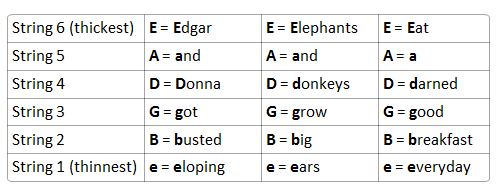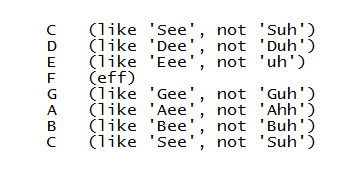Subject: Memorize the Fingerboard (Part 4)
You are getting this e-mail because you subscribed to it on www.learn-to-play-rock-guitar.com. If you don't want to receive these e-mails any longer, go to the bottom of this message and click on "unsubscribe." Hey there Friend, Now that we've covered the location of each note on the fingerboard, I thought I'd give you some simple exercises to help you memorize note locations. In these exercises, we'll focus on the natural notes (again, the main notes in the musical scale - you know, A, B, C D, E, F and G). By knowing where these notes are, it's very simple to know which frets have sharps/flats. In order to remember the string names, you can use a fun little tool called a mnemonic device. You take each string name letter and come up with a small phrase using each string letter as the first letter of each word in the phrase. Our string names are E,A D, G, B and e. So come up with a funny phrase using each of those letters to remember the strings in the proper order. Or use one of these:  While it doesn't have to be a silly phrase, mnemonics tend to be more effective if they are a bit goofy because of the contrast between something a bit serious versus a goofy word trick. The sillier the better, because you're more likely to remember something that gives you a chuckle every time you think about it. You'll literally have the string names memorized within a couple minutes with the phrase you invent (or use one of these above). As we've already talked about, the octave position for each string is located at the twelfth fret. Again, the twelfth fret usually has double dots as the marker on the fingerboard. We know that at this twelfth fret the note is going to be the same for each string as the string name. All the notes that you memorize in the first 11-fret section of the neck are now repeated. If you have an acoustic guitar, you are not going to have much fingerboard real estate above the twelfth to think about. You may be able to reach the fifteenth or seventeenth fret, but it will be a challenge to play much up there. However, if you have an electric guitar, you'll be able to easily reach most if not all of the frets on the neck. Everything from the twelfth fret and higher is a repeat of the first eleven frets, so once you've memorized those, you shouldn't have any trouble with the upper section of the finger board. EXERCISES Before you begin any exercise on your guitar, it's extremely important that you make sure your guitar is in perfect tune. The purpose for this is that in addition to learning where the notes are on the fingerboard, you're going to be training your ears to hear the notes properly. Ear training is extremely important in helping you learn music. Consider this a two-for-one deal! As you become more familiar with note locations, you'll begin to notice when a pitch is slightly off - a little sharp or flat. You'll be able to hear this in relation to both the pitch itself and in relation to other string pitches. I encourage you to start a practice journal. Each day you'll create a short entry detailing what you practiced and any observations you have. You can do this on your computer, or get yourself a spiral notebook to keep track of your progress (a notebook might actually be easier to jot down notes). OK, let's begin. DAY 1. Pick one string to work on. You're going to focus exclusively on that string. Let's choose the B string (string 2). Now starting with the open string, pluck the B note. Sing the pitch that you hear. Next, place your index finger on the string at the first fret - the C note. Play the note and sing the note name - don't worry, no one is listening - and so what if they are?! So you start with 'Bee', then 'Cee', then 'Dee', etc. Repeat the process until you have played each fret and sung each note up to the twelfth fret. Use the chart to help you along:  Good job! Take a break for the day, or play some 'Smoke on the Water' or 'Free Bird' or 'Stairway to Heaven' or something. Maybe a little 'Eruption'. DAY 2. Practice the B string again. You should be able to work through it pretty quickly now that you know the exercise. Now pick another string and repeat yesterday's exercise. Continue this every day until you have practiced each string. On the seventh day, take a break.  DAY 8. Choose one note and find every location for that note on the fingerboard. Remember that each note occurs only once for each octave, which on a guitar spans twelve frets. Focus your efforts on only the guitar neck area between the first twelve frets. For each note, play the note, then sing the note to the best of your ability. Spend five seconds studying each location of the note you have chosen to play:
You should use this exercise first on all the natural notes. By the time you have gotten through all eight pitches (the octave is the eighth natural pitch in the series from the open string to the twelfth fret), you'll have a good feel for where all the natural notes are on the fingerboard. For the last exercise, we'll incorporate a scale into the process. These can be done every day to keep you sharp. Play a scale and sing the notes as you play them. As you play and sing each note, pay attention to the fret each note is on. For example, on the eighth fret of low E string, play the note and sing a long 'C' sound as you play it (like 'See', not 'Suh').   You can do this exercise with all of the scales. I chose the major scale in the key of C because there are no sharps (#) or flats (b) that you have to contend with. Just be aware that when you practice another key, you need to know which notes are sharped or flatted in that key. Of course there are tools to help you remember that information. Looks like a topic for another email! Oh, I almost forgot - I will be posting these articles up on my website, so if you missed a section, they'll all be available soon. I'll also make a printable version of the charts in the articles. Until next time, rock on! Peace~ Dave Dave "Eddie" Vance is a rock guitar enthusiast and gear nut. He has been playing guitar for over 30 years and enjoys tormenting the neighbors every chance he gets. When he's not slaving for the man, you can find him rocking out with his B.C. Rich Bich guitar, a cold beer and some sweet tunes. He also runs Learn-To-Play-Rock-Guitar.com, but you knew that already! Follow Learn To Play Rock Guitar:I welcome your feedback! Did you like today's message? What other topics would you like to see covered in my e-mails? Please let me know at: dave@learn-to-play-rock-guitar.com As always, please feel free to forward this email to a friend! I review products before recommending them. If you buy a product based on my recommendation, I will receive a commission. However, my emails also contain links that don’t require any investment on your part and are jam-packed with "juicy, guitar learnin' tastiness". We don't rent or share your name with anybody. Feel free to forward this issue to any friends you think would enjoy its contents. They will thank you. So will I.
|


